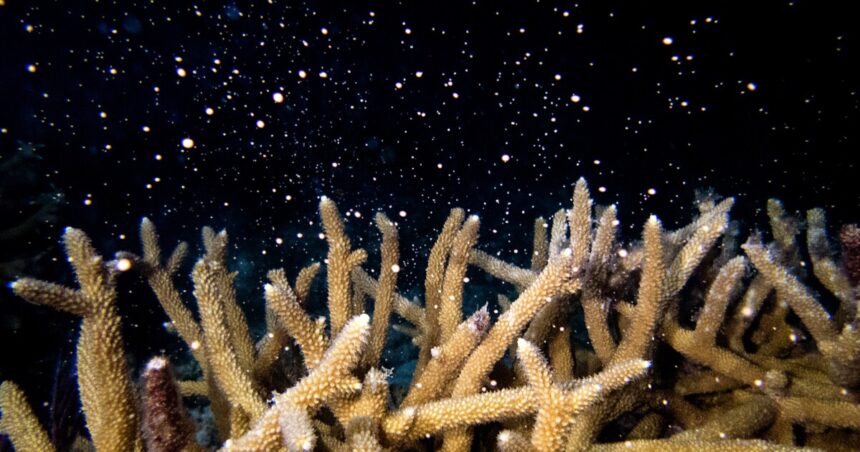Scientists racing to save coral from bleaching reefs across the Florida Keys got some rare good news: a handful of coral rescued off Miami spawned in the University of Miami’s Rosenstiel hatchery lab this week.
While it’s too soon to know whether they’ll become viable, making babies could definitely be a good sign for coral that have endured weeks of punishing heat.
“The fact that some of them spawned is good. We’re sort of optimistic that tonight we may get even more of them spawning,” said marine biologist Andrew Baker, whose Reef Futures Lab is managing the spawning coral, on Thursday.
But he’s not quite ready to hand out cigars.
“There could be these kind of cryptic effects of the heat stress on the corals.” he said, meaning the eggs and sperm could still not fertilize. “The first step in the reproductive process. But so far, so good.”
The coral now in the lab were rescued from two nurseries off Key Biscayne where coral have so far remained healthy.

Across the Keys, reefs are in much more dire shape. The National Oceanic and Atmospheric Administration has documented all coral at Cheeca Rocks affected by bleaching. And at Sombrero Reef, UM researchers say bleaching is also widescale, including slow-growing boulder coral that help build reef foundations.
Florida’s beleaguered reef, the only inshore barrier reef on the U.S. mainland, has suffered years of damage from pollution and over-fishing, as well as increasing stress from climate change.
The reef not only provides a powerful barrier to storm surge — also expected to worsen as the planet warms — but helps provide Florida with a thriving tourism economy. Reef restoration work has now been going on for more than decade, with a handful of offshore nurseries mostly growing staghorn coral expanding up and down the coast.
“Out in the wild, lots of [these larvae] probably end up just being washed off the reef or eaten by predators.”
Marine biologist Andrew Baker
Last week, UM began removing corals from its nursery to preserve genetic diversity and also hope to capture spawning that typically begins in August. Spawning corals in labs allowed scientists to better manage the babies and give them a better shot at surviving later on the reef.
READ MORE: Scientists racing to save coral from bleaching are running out of space
“Out in the wild, these larvae wouldn’t be in petri dishes and being maintained in closed systems,” Baker said. “Out in the wild, lots of them probably end up just being washed off the reef or eaten by predators.
“So we are actually hoping that by managing the breeding process, by looking after these things, as long as we keep everything clean and happy, we’ll actually get a much greater rate of return on these babies.”
‘We got spawn!’
Colonies of staghorn spawned Wednesday and again on Thursday night in the Virginia Key lab, with Marvin Gaye playing on an iPhone and industrial fans blowing away mosquitoes.

Diana Udel
/
University of Miami Rosenstiel School
“We got spawn!” Baker cheered when the tiny milky sacks appeared in the tank. “Each one of those little dots represents dozens or possibly even hundreds of eggs, and it’s all bundled together with sperm.”
The team that had been watching tanks containing the elkhorn and staghorn quickly zeroed in, with some lab workers using pipettes, which look like large droppers, to suction up the bundles and deposit them in beakers to be moved to an indoor lab. Others aimed red headlamps into the water looking for more spawn. After about an hour, most of the bundles had been sucked up and no more spawn appeared.
Meanwhile off Key Largo, another crew reported successfully collecting egg and sperm sacks from spawning elkhorn.
For the two teams, Baker said the work was just getting started.
“Now the team really has to spend hours basically carefully fertilizing these sperm and eggs, cleaning up the resulting fertilized eggs, and raising them, and making sure they stay happy,” he said. “That will mean probably a four or five o’clock in the morning finish for the team.”
After a few hours sleep, he said they’d be back in the lab again to check on the coral.

Diana Udel
/
University of Miami Rosenstiel School
“They’re just trying to keep them going through these really delicate first few hours of their life,” he said.
Coral typically begin to spawn in August with staghorn going first followed by elkhorn and boulder. But it’s hard to tell what will happen this year, Baker said.
“We’ve got nothing really to compare it against because we’ve never had a bleaching event this early when these guys are actually spawning,” he said.
Next, looking for signs of fertilization
Over the next few days, lab workers will watch for signs that the larvae have fertilized and are beginning to attach to surfaces in the tank and build skeletons. If they do, baby coral will be tended to for the next few months and released once waters begin to cool.
“Once we get into sort of October, I think we will be thinking about when we should be releasing these. And it’ll depend a little bit on local conditions,” he said.
Longer term, if climate change continues to warm oceans, Baker said scientists will need to start thinking more strategically about coral breeding programs.
“Thinking about the Caribbean Basin, there are corals all over the Caribbean that live in very different thermal environments, some warmer than others,” he said.
“I think there’s a big scientific conversation to be had there about sourcing parents from warmer environments and using them to expand our pool of genetic diversity to really try to generate the most thermally tolerant and then really think carefully about where those offspring should go.”
Sign up for WLRN’s environment newsletter Field Notes to receive our insider’s guide for living in South Florida’s changing landscape. Get original reporting and recaps, with context, delivered to your inbox every Friday. Subscribe here.











